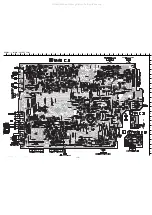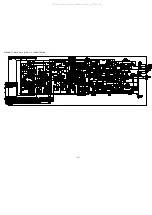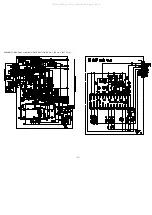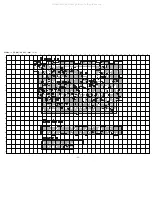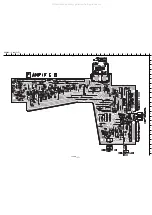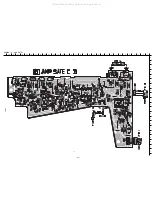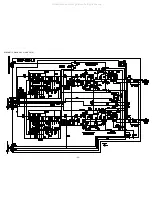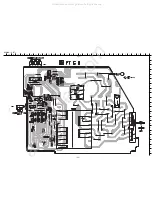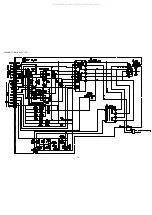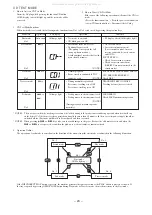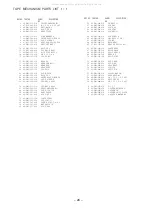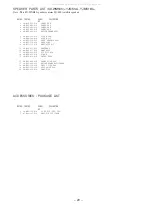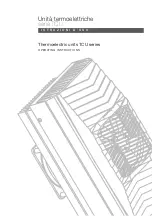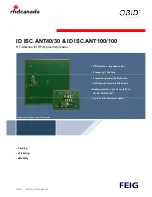
– 23 –
1. Clock Frequency Check
Settings : • Test point : TP2 (CLK)
Method : Set to MW 1602kHz and check that the test point is
2052kHz
±
45Hz.
2. MW VT Adjustment
Settings : • Test point : TP1 (VT)
• Adjustment location : L953
Method : Set to MW 1602kHz and adjust L953 so that the test
point becomes 8.5V
±
0.05V. Then set to MW 531kHz
and check that the test point is more than 0.3V.
3. MW Tracking Adjustment
Settings : • Test point : TP8 (Lch), TP9 (Rch)
• Adjustment location :
L952 ................................................ 603kHz
TC941 ........................................... 1404kHz
Method : Set up TC941 to center before adjustment.
The level at 603kHz is adjusted to maximum by L952.
Then the level at 1404kHz is adjusted to maximum by
TC941.
4. AM IF Adjustment
Settings : • Test point : TP8 (Lch), TP9 (Rch)
• Adjustment location :
L802 ................................................ 450kHz
Method : Adjust L802 so that the output becomes maximum.
5. SW VT Adjustment
Settings : • Test point : TP1 (VT)
• Adjustment location : L942
Method : Set to SW 17.9MHz and adjust L942 so that the test
point becomes 8.0V
±
0.05V. Then set to SW 5.73MHz
and check that the test point is more than 0.3V.
6. SW Tracking Adjustment
Settings : • Test point : TP8 (Lch), TP9 (Rch)
• Adjustment location :
L941 ............................................. 5.73MHz
TC943 .......................................... 17.9MHz
Method : Set up TC943 to center before adjustment.
The level at 5.73MHz is adjusted to maximum by L941.
Then the level at 17.9MHz is adjusted to maximum by
TC943.
7. FM VT Check
Settings : • Test point : TP1 (VT)
Method : Set to FM 87.5MHz, 108.0MHz and check that the test
point is more than 0.5V (87.5MHz) and less than 8.0V
(108.0MHz).
8. FM Tracking Check
Settings : • Test point : TP8 (Lch), TP9 (Rch)
Method : Set to FM 98.0MHz and check that the test point is
less than 9dB
µ
V.
9. DC Balance / Mono Distortion Adjustment
Settings : • Test point : TP3, TP4 (DC Balance)
: TP8 (Lch), TP9 ( Rch) (Distortion)
• Adjustment location : L801
• Input level : 60dB
µ
V
Method : Set to FM 98.0MHz and adjust L801 so that the
voltage between TP3 and TP4 becomes 0V
±
300mV
with minimum distortion.
< TUNER SECTION >
ADJUSTMENT <TUNER / DECK / FRONT>
10. Tape Speed Adjustment (DECK 2)
Settings : • Test tape : TTA–100 (3kHz)
• Test point : TP5 (Lch), TP6 (Rch)
• Adjustment location : SFR1
Method : Play back the test tape and adjust SFR1 so that the
frequency counter reads 3000Hz
±
5Hz (FWD) and
FWD SPEED
±
45Hz (REV).
11. Head Azimuth Adjustment (DECK 1, DECK 2)
Settings : • Test tape : TTA–300
• Test point : TP5 (Lch), TP6 (Rch)
• Adjustment location : Azimuth adjustment screw
Method : Play back (FWD) the 10kHz signal of the test tape
and adjust screw so that the output becomes maximum.
Next, perform on REV PLAY mode.
12. PB Frequency Response Check (DECK 1, DECK 2)
Settings : • Test tape : TTA–330
• Test point : TP5 (Lch), TP6 (Rch)
Method : Play back the 315Hz and 10kHz signals of the test tape
and check that the output ratio of the 10kHz signal with
respect to that of the 315Hz signal is 0dB
±
3dB.
13. PB Sensitivity Check (DECK 1, DECK 2)
Settings : • Test tape : TTA–200 (400Hz)
• Test point : TP5 (Lch), TP6 (Rch)
Method : Play back the test tape and check that the output level of
the test point is 280mV
±
3dB.
14. REC/PB Frequency Response Adjustment (DECK 2)
Settings : • Test tape : TTA–602
• Test point : TP5 (Lch), TP6 (Rch)
• Input signal : 1kHz / 10kHz (LINE IN)
• Adjustment location : SFR351 (Lch)
SFR352 (Rch)
Method : Apply a 1kHz signal and REC mode. Then adjust OSC
attenuator so that the output level at the TP5, TP6
becomes 28mV. Record and play back the 1kHz and
10kHz signals and adjust SFRs so that the output level
of the 10kHz signal becomes 0dB
±
1dB with respect to
that of the 1kHz signal.
15. REC/PB Sensitivity Check (DECK 2)
Settings : • Test tape : TTA–602
• Test point : TP5 (Lch), TP6 (Rch)
• Input signal : 10kHz (LINE IN)
Method : Apply a 10kHz signal and REC mode. Then adjust OSC
attenuator so that the output level at TP5, TP6 becomes
280mV. Record and play back the 10kHz signal and
check that the output is –1dB
±
3dB.
< FRONT SECTION >
1.
µ
-CON OSC Adjustment
Settings : • Test point : TP9 (KEY SCAN) and TP10 (GND)
• Adjustment location : L101
Method : Insert AC plug while pressing TUNER function key and
POWER key. Adjust L101 so that the frequency at the
test point becomes 208.80Hz
±
0.2Hz.
< DECK SECTION >
All manuals and user guides at all-guides.com
Summary of Contents for NSX-VC87
Page 12: ... 12 SCHEMATIC DIAGRAM 2 MAIN 2 3 TUNER SECTION All manuals and user guides at all guides com ...
Page 18: ... 18 SCHEMATIC DIAGRAM 5 AMP 1F All manuals and user guides at all guides com ...
Page 20: ... 20 SCHEMATIC DIAGRAM 6 AMP SATE All manuals and user guides at all guides com ...
Page 22: ... 22 SCHEMATIC DIAGRAM 7 PT All manuals and user guides at all guides com ...


